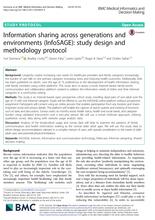
Abstract
Background: Longevity creates increasing care needs for healthcare providers and family caregivers. Increasingly, the burden of care falls to one primary caregiver, increasing stress and reducing health outcomes. Additionally, little has been published on adults’, over the age of 75, preferences in the development of health information sharing with family members using online platforms. This study aims to assess a novel, Internet based, family-centric communication and collaboration platform created to address the information needs of elders and their informal caregivers in a community setting.
Methods: This study is an internet-based, open prospective cohort study, enrolling dyad pairs of one adult over the age of 75 with one informal caregiver. Dyads will be offered to use the InfoSAGE online platform without prospective assignment. Participants will consent using an online process that enables participation from any location and shares important study and privacy details. The platform will enable the capture of search queries and tracking of functions such as tasks and discussions. Surveys every six months assess health status, health and social needs, and caregiver burden using validated instruments over a two-year period. We will use a mixed methods approach, utilizing qualitative survey data along with website usage analytic data.
Discussion: Analysis of the longitudinal usage and survey data will help to examine the patterns of family communication and health information seeking as the central older adult ages. We will use the study data to inform design recommendations relevant to a complex mixture of users, with special consideration to the needs of older adult users and potential physical limitations.
